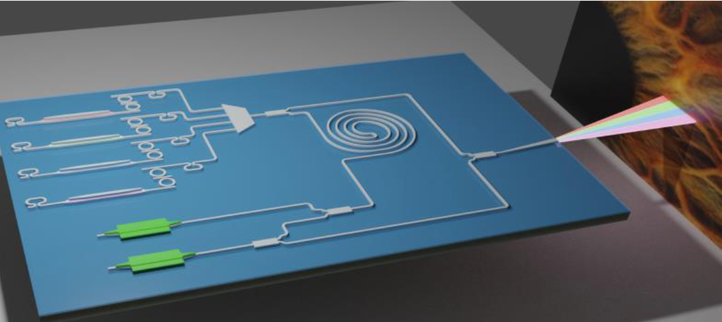Cluster 4 - VISSION

Introduction
VISSION is a Horizon Europe RIA project entitled “Active Building Blocks for Visible and Near-Infrared Applications on a Silicon Nitride Interposer”. VISSION aims to extend the silicon nitride (SiN) photonic integrated circuit (PIC) platform for the visible and near-infrared wavelength range (400 nm–1100 nm) with active building blocks including sources, detectors and modulators. The consortium consists of 7 partners from 5 countries: research institutes (IMEC, UNIPRESS, Ferdinand-Braun Institute), companies (Gooch & Housego, Luceda, Sarcura) and Ghent University. IMEC is coordinating the project. VISSION will run from 1 September 2022 to 31 August 2026.
Project description
VISSION aims to extend the silicon nitride (SiN) photonic integrated circuit (PIC) platform for the visible and near-infrared wavelength range (400 nm–1100 nm) with active building blocks including sources, detectors and modulators. The spectral range is the region of interest for a large number of life science applications, environmental sensing and atom based quantum technology. Concrete application examples are optical coherence tomography systems, flow cytometers, water pollution sensors, optical clocks, and ion based quantum computers. Today, the majority of these systems rely on fiber based or free space optical components, limiting their widespread use. The envisioned active PIC platform will allow for a reduction in size and cost of existing systems, and improvements in robustness, energy efficiency, and speed. On-chip integration also offers possibilities for increased system complexity and the corresponding added functionality. To realize this active PIC platform, we will enhance the existing passive SiN platform with heterogeneously integrated active materials. Today’s SiN PIC technology features passive components with excellent performance, but active functionality is lacking. We will add on-chip active building blocks – III-V and III-N lasers, PZT modulators and Si detectors – operating at visible and near-IR wavelengths. The heterogeneous integration will be enabled through micro-transfer printing. Both techniques allow for the integration of multiple active materials on the same chip, which is necessary if sources, modulators and detectors operating over a wide wavelength range are to be integrated on a single chip. The generic building blocks developed in VISSION will be added to a process design kit (PDK), allowing future platform users to build complex on-chip systems. The VISSION PIC technology will be validated by component and system level testing of an OCT system and cytometry.
Objectives
The objectives in the VISSION project are the following:
- Demonstrate a platform that is broadband, covering the range 400 nm – 1100 nm.
- Demonstrate the future proof modular integration techniques needed to allow for the integration of active generic components on the silicon nitride (SiN) interposer.
- Demonstrate the application-specific system and sub-system circuits that include both the actives and passives.
- Develop a strategy that allows for wide accessibility to the platform for photonic designers.
Role of Ghent University
UGent will develop high-quality optical phase modulators based on transfer printing of electro-optic thin films made of lead zirconate titanate (PZT). The PZT deposition process will be optimized for uniformity on larger substrates at visible wavelengths. A transfer printing process will be developed for these PZT thin films and electro-optic modulators will be designed including coupling sections and electrode patterning.
Website
To be announced
Contact
Prof. Jeroen Beeckman
Department of Electronics and Information Systems
Phone number: +32 9 264 33 76
E-mail
Funding info
Disclaimer
Funded by the European Union. Views and opinions expressed are however those of the author(s) only and do not necessarily reflect those of the European Union or the European Health and Digital Executive Agency (HADEA). Neither the European Union nor the authority can be held responsible for them.
